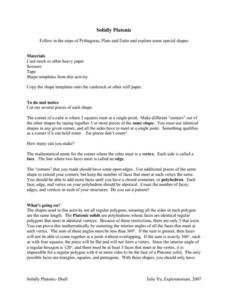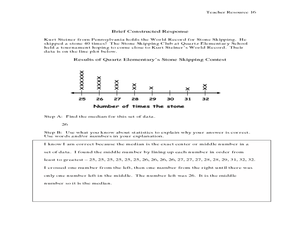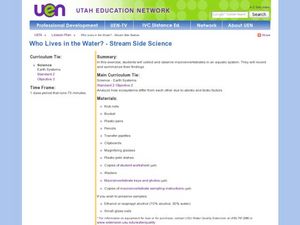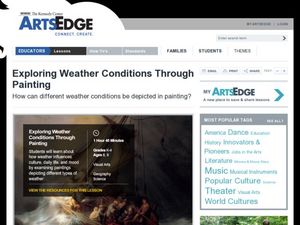Curated OER
How Does a Thermometer Work?
Students explore how a thermometer works. In this temperature instructional activity, students use a glass bottle, a straw, and food coloring to construct a homemade thermometer. Students record observations.
Curated OER
The Great Water Hunt
Students create a model of the land to water ratio in a large group and search for all the places water is used at their school while on a Great Water Hunt. They identify where water can be found and compare how much of world is covered...
Curated OER
Observing Apples - Skill Lesson
First graders listen to a story about Johnny Appleseed read by their teacher. They discuss his life as a class and describe what they see when a cut apple is before them. They draw a picture of what they see and write three adjectives...
Curated OER
Writing About Art: Comparing Portraits
Students write a composition comparing and contrasting two portraits. In this comparing and contrasting lesson, students will observe two portraits and compare them through their writing. They then will write a letter to the artists...
Curated OER
About Life: The Photographs of Dorothea Lange
Students use art to analyze a period in history. For this lesson about the effect of art on history, students study many different pieces of photography by Dorothea Lange. Students will observe photographs from certain time periods and...
Curated OER
Old Made New
Students explore recycling. In this science lesson, students sort everyday objects based on their properties. Students view examples of items made from recycled paper. Students create recycled paper.
Curated OER
Let's Travel to Mexico!
Students investigate and explore information about Mexico. They listen to a story, view an Internet video, write a page for a class book, and play an online Spanish word concentration game.
Curated OER
Refining the Why? Turning Student Questions into Research
Middle schoolers have years of experience when it comes to how their bodies work. Surely they have some questions as well. Here is an opportunity for them to practice the scientific method in an attempt to answer some of those questions....
Curated OER
Ring of Fire
Students locate some of the 1,500 active volcanoes on a world map. Then by comparing their maps with a map of the world's tectonic plates, they discover that volcanoes occur because of the dynamic nature of the Earth's lithosphere.
Curated OER
Solidly Platonic
When they do, they learn. Using this resource, young mathematicians learn about platonic solids by actually building, touching, and examining the shapes. They connect their observations about the shapes to Euler's formula.
Curated OER
Kool Kumara Lesson Plans
Students explore and observe the plant world and acquire knowledge about the functional parts of plants. For this Kool Kumara lesson, students make observations and record specific data on a recording sheet. Students estimation length,...
Science 4 Inquiry
Phases of the Moon
The moon takes just over 27 days to orbit around Earth. Young scientists position themselves as the earth as they rotate around the sun and hold the moon. This allows them to observe the patterns and phases of the moon.
Science 4 Inquiry
Deforestation
Young scientists observe deforestation from satellite photos and discuss the importance of forests to the global environment. They then simulate a plot of forest when farmers move into the area over the course of seven years. Finally,...
National Security Agency
Are You Ready to Call the Guinness Book of Records?
Learners design questions that can be answered by collecting data. In this line-plot lesson, pupils collect data and graph on a line plot on world records. An abundant supply of teacher support is provided in this resource.
Curated OER
Who Lives in the Water? Stream Side Science
Andree Walker thought of everything when he wrote this resource. It includes a detailed list of materials and background information links for the teacher. In addition, it has procedures, a macroinvertebrate identification key, and tally...
Curated OER
Archeologists For a Day
Students listen to a reading about fossils and go on a hunt for items with fossil characteristics. In this cross curricular fossil instructional activity, students will examine their fossil finds and create a graphic organizer. ...
Curated OER
I Wonder How the Manduca Life Cycle Compares To the Human Life Cycle...
Students study life cycles including developing their understanding of the human life cycle. They decide where they are in the human life cycle and provide reasons for that placement. They compare the human life cycle to that of the...
Curated OER
Exploring Weather Conditions Through Painting
Your advanced class will paint a picture of a particular weather condition. In this painting lesson students describe elements of art in pieces of artwork. They analyze the weather and seasons in the artwork. The students use paper,...
Curated OER
An Introduction to the Night Sky and Movement Astronomy
Basically, this is an interactive exploration of educational astronomy software and an app. Young astronomers discover how the apparent motion of the sky relates to Earth's movements and the position of the observer. It is out of this...
National Library of Medicine
Electricity, Frankenstein, and the Spark of Life
Shocking! After viewing a short clip from the 1931 movie, Frankenstein and reviewing electricity references in Mary Shelley's novel, class members examine Luigi Galvani's and Alessandro Volta's observations on electricity and muscle...
Curated OER
Stretching the Truth
Sixth graders visualize different percentages as parts of a whole on visual images. They observe alterations of photographs, and models of circles, squares and sets. This incredibly detailed, eight-page plan leads you through everything...
Curated OER
A First Look at the Garden
For any teacher who is planning a field trip to Missouri's Botanical Garden, this instructional activity packet is a must-have! In it, young learners engage in pre-visit activities so they will be prepared to get the most out of their...
Curated OER
Keying Rocks
Young geologists learn how to use an identification key in order to classify rocks. The key is designed to help them classify rocks into three types: ignesous, metamorphic, and sediimentary. After an initial teacher-led demonstration,...
Curated OER
Eggs'ceptional Experiments
Young scholars see evidence of chemical reaction and follow the scientific method to hypothesize, observe, and reach conclusions. They conduct a series of egg based experiments such as forming crystals and complete journal activities as...

























